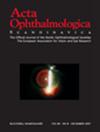Objective measurement of accommodation in patients with an accommodating intraocular lens compared to phakic, presbyopic, and pseudophakic eyes
Abstract
Aims/Purpose: The restoration of accommodation after cataract surgery remains to be one of the biggest challenges in ophthalmology. Numerous concepts for restoration of accommodation have failed due to a lack of objective accommodation measurement. The purpose of this study was to demonstrate the dynamic pseudophakic accommodation in patients with an accommodative AIOL by means of an objective accommodation measurement and to compare the data with a young phakic, a presbyopic and a monofocal pseudophakic person.
Methods: We included 3 patients in the study who had a Lumina AIOL implanted in both eyes. All patients had completed at least the 6 month follow-up. In addition, we included both eyes of 3 comparative persons with different status of the lens (phakic, presbyopic and pseudophakic). We used a binocular open-field videorefractor (PowerRef 3, Plusoptix GmbH, Germany) to measure the change of refraction, pupil diameter and ocular convergence while patients were asked to focus on an ETDRS chart. The ETDRS chart was then continuously moved from 6m distance to 33 cm distance while the patients were asked to focus on a single letter. The resulting curves were then compared to demonstrate the objective change in refraction.
Results: The data exhibit a continuous change of binocular refraction which follows the pupil constriction and decrease of pupil distance (convergence) in the young phakic person and the AIOL patients. The maximum accommodative change was up to 2.5 D in the AIOL patients and up to 3 D in the young phakic person for a stimulus distance of 33 cm. The presbyopic patient and the monofocal pseudophakic patient showed pupil constriction and convergence but the accommodative range was less pronounced with a maximum change of 1 D.
Conclusions: The PowerRef 3 allows for an objective proof of pseudophakic accommodation in patients with an AIOL. AIOL eyes show defined change of refractive power that can be maintained constant for the time of fixation to a near target compared to presbyopic and monofocal pseudophakic eyes that show only little modulation, which can be attributed to pseudo-accommodative effects.

 求助内容:
求助内容: 应助结果提醒方式:
应助结果提醒方式:


